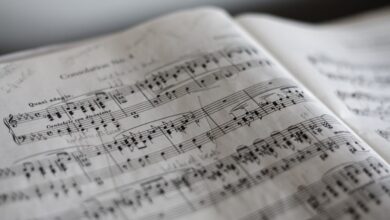Understanding the Role of Music in Cross-Cultural Communication and Understanding

Have you ever wondered how music can transcend boundaries and bring people from different cultures together? Music has a unique way of connecting individuals, fostering cross-cultural communication, and promoting understanding among diverse communities. In this article, we will delve into the fascinating role of music in bridging cultural gaps and facilitating mutual comprehension.
Music serves as a universal language that surpasses spoken words or written texts. It taps into our emotions, resonates within us, and evokes powerful feelings that are universally understood. Regardless of our cultural background or native tongue, we can all appreciate a catchy melody, a rhythmic beat, or a soul-stirring harmony. This shared experience creates an immediate connection, transcending language barriers and enabling communication on a deeper level.
Imagine attending a music festival where musicians from different parts of the world come together to perform. The vibrant sounds of various instruments blend harmoniously, weaving a tapestry of melodies that reflects the diversity of cultures represented. As you soak in the music, you find yourself transported to distant lands, mentally exploring new horizons. Through this musical journey, you gain insights into the traditions, values, and stories of other cultures, expanding your worldview and fostering empathy.
Furthermore, music has the power to convey emotions and narratives that words alone may struggle to express adequately. It can communicate joy, sorrow, longing, celebration, and a multitude of other human experiences in a profound way. When we listen to music from different cultures, we gain access to their emotional landscapes, allowing us to empathize with their joys and sorrows. This shared emotional connection deepens our understanding of one another, enhancing cross-cultural dialogue and mutual appreciation.

Think of music as a bridge that connects two separate shores. Just as a bridge facilitates the passage between two physical locations, music acts as a conduit for cultural exchange. It enables us to traverse the gap between our own cultural perspective and that of others. By actively engaging with music from different cultures, we actively participate in a dialogue that transcends words, enriches our understanding, and fosters harmony among diverse communities.
Music plays a pivotal role in facilitating cross-cultural communication and understanding. It unites people through its universal language, creating connections that surpass cultural boundaries. By embracing music from diverse cultures, we can broaden our horizons, nurture empathy, and build bridges that bring us closer together as a global community. So, let the melodies guide you on a journey of discovery, and open your heart and mind to the transformative power of music.
Harmony Beyond Borders: How Music Bridges Cultural Divides and Fosters Understanding

Introduction:
Have you ever experienced a powerful connection with someone from a different culture through the universal language of music? Music has an incredible ability to transcend barriers and bring people together, fostering understanding and harmony that goes beyond borders. In this article, we will delve into the enchanting world of music and explore how it bridges cultural divides, creating a shared platform for cultural exchange and appreciation.
Breaking Down Barriers:
Music has an innate ability to break down barriers that exist between cultures. Regardless of our diverse backgrounds and languages, we can all relate to the emotions conveyed through melodies and rhythms. Whether it’s a captivating guitar solo, a mesmerizing violin concerto, or the rhythmic beats of a drum, music speaks directly to our souls, bypassing linguistic and cultural differences.
Cultural Exchange and Appreciation:
Through music, we gain a window into different cultures, allowing us to appreciate and understand them on a deeper level. Traditional folk songs, classical compositions, and contemporary tunes embody the essence of a culture, its history, struggles, and triumphs. When we embrace and engage with music from other cultures, we open ourselves to new perspectives, broadening our horizons and fostering a sense of unity.
Unifying Humanity:
Beyond breaking down barriers and facilitating cultural exchange, music has the remarkable power to unite humanity. It serves as a catalyst for social change, promoting empathy, compassion, and solidarity. Think about the anthems that inspire us during challenging times, rallying people together in pursuit of a common goal. Music ignites passion and mobilizes communities, reminding us of our shared humanity.
Education and Empowerment:
In addition to its unifying qualities, music plays a vital role in education and empowerment. It provides a platform for self-expression, allowing individuals to tell their stories, express their identities, and advocate for social justice. By engaging with music from various cultures, we cultivate empathy and respect for diversity. Music education programs that incorporate different cultural traditions foster a generation of global citizens who appreciate and celebrate our collective heritage.
Conclusion:
In a world often divided by borders and cultural differences, music emerges as a unifying force, fostering understanding, empathy, and appreciation. It breaks down barriers, facilitates cultural exchange, unites humanity, and empowers individuals. So let us embrace the enchanting melodies that traverse cultural divides, allowing music to guide us on a journey towards harmony and shared understanding.
Unlocking the Power of Melody: Exploring Music’s Universal Language in Cross-Cultural Communication
Have you ever wondered how music can transcend language barriers and connect people from different cultures? It’s fascinating to delve into the power of melody and its ability to communicate emotions, stories, and ideas across diverse backgrounds. In this article, we will explore how music serves as a universal language in cross-cultural communication.
Music, with its captivating melodies and rhythmic patterns, has an incredible capacity to evoke emotions within us. Whether it’s joy, sadness, or excitement, music can stir feelings that are universally understood. When we listen to a beautiful melody, we are transported to a realm where words are unnecessary, and we can connect on a deeper level with others who share the same experience.
In cross-cultural communication, where language differences can hinder understanding, music acts as a bridge. It allows individuals to express themselves authentically and encourages empathy and appreciation for other cultures. Through music, we can celebrate diversity and find common ground, fostering a sense of unity.
Just like spoken language, music has its own grammar and vocabulary. Different musical traditions have their unique styles, instruments, and rhythms. When we embrace these differences, we open doors to new perspectives and broaden our cultural horizons. By embracing the melodies of various cultures, we gain insight into their values, traditions, and history.
Imagine a symphony orchestra consisting of musicians from different corners of the world. Each musician brings their own cultural background and musical expertise to create a harmonious masterpiece. Despite their diverse origins, they come together through the shared language of music, producing an awe-inspiring performance that transcends boundaries.
Music holds immense power as a universal language in cross-cultural communication. It breaks down barriers, creates connections, and fosters mutual understanding. Through its enchanting melodies and diverse expressions, music unites us, reminding us of our shared humanity. So, let’s embrace the beauty of different musical traditions and allow melody to bring us closer together in this vast world of cultural diversity.
From Rhythm to Connection: The Intricate Dance of Music in Cultivating Cross-Cultural Understanding

Have you ever experienced the magic of music? It has a way of transcending barriers, touching our souls, and bringing people together. In the realm of cross-cultural understanding, music takes on an even more profound role. It becomes a universal language, capable of bridging the gaps between diverse communities and fostering a deeper sense of connection.
Music is a rhythmic force that knows no boundaries. It pulsates through our veins, stirring emotions and igniting a sense of shared experience. Regardless of our cultural backgrounds, we can all tap our feet to a catchy beat or get lost in the enchantment of a melodic tune. This common ground forms the foundation upon which cross-cultural understanding can flourish.
The beauty of music lies in its ability to preserve and express cultural heritage. Each culture has its own unique musical traditions, instruments, and rhythms that reflect its history, values, and identity. Through music, we gain insight into the rich tapestry of human experiences across the globe. We become immersed in the vibrant melodies of African drumming, the intricate sitar compositions of India, or the soulful ballads of Latin America. In this way, music becomes a portal that transports us to different corners of the world, allowing us to appreciate and understand diverse cultures.
But music doesn’t just showcase cultural diversity; it also unites us through shared emotions. Think about the last time you attended a live concert or danced to your favorite song at a party. In those moments, did you feel a sense of camaraderie with the people around you, regardless of their background? That’s the power of music. It creates a sense of belonging, breaking down barriers and fostering empathy. It reminds us that, despite our differences, we all share common joys, sorrows, and aspirations.
Moreover, music serves as a catalyst for dialogue and collaboration. When musicians from different cultures come together to create music, something extraordinary happens. They blend their unique styles, instruments, and techniques, resulting in a harmonious fusion that transcends boundaries. Collaborative projects like these not only produce beautiful melodies but also promote understanding, respect, and appreciation for one another’s cultural heritage.
Music is more than just a sequence of sounds. It is an intricate dance that moves us, connects us, and cultivates cross-cultural understanding. Through its universal language, music breaks down barriers, preserves cultural heritage, evokes shared emotions, and sparks collaborative conversations. So, let the rhythm guide you on this extraordinary journey of exploration, acceptance, and connection with people from all walks of life.
Tuning In to Diversity: How Music Breaks Barriers and Builds Cultural Empathy
Are you ready to embark on a melodic journey that transcends boundaries and unites people from different cultures? Music, with its enchanting rhythm and soul-stirring melodies, has the power to break barriers and foster cultural empathy like no other art form. By embracing diversity through harmonious notes, music sparks conversations, opens hearts, and paves the way for a more inclusive society.

Imagine a symphony orchestra, each instrument playing its part in perfect harmony. Just like the diverse members of an orchestra, music brings together individuals from various backgrounds and traditions. Regardless of language or origin, the universal language of music speaks directly to our emotions, bypassing any preconceived notions or biases we may hold. It connects us on a deeper level, reminding us of our shared humanity.
Through music, we gain a profound understanding of different cultures. From the rhythmic beats of African drums to the serene melodies of Indian sitar, each musical tradition tells a unique story about a particular community’s history, values, and struggles. As we immerse ourselves in these cultural treasures, we develop a newfound appreciation and respect for the richness and diversity of our world.

Moreover, music acts as a bridge between cultures by blending various styles and genres. Think of collaborations between musicians from different countries, effortlessly fusing their sounds to create something extraordinary. These cross-cultural collaborations not only produce captivating compositions but also serve as a metaphor for unity and cooperation. They remind us that when we embrace diversity and work together, we can create something truly remarkable.
Beyond fostering cultural understanding, music has the power to heal and uplift. It transcends borders, soothing troubled souls and inspiring hope in the face of adversity. In times of crisis, music becomes a beacon of light, uniting communities and providing solace to those in need. Whether it’s through a heartfelt ballad or an empowering anthem, music has the ability to ignite change and give voice to marginalized groups, amplifying their stories and struggles.
Music serves as a transformative force that breaks down barriers and cultivates cultural empathy. As we tune in to the diverse melodies of our world, we open ourselves to new perspectives, embrace differences, and build bridges between communities. So let the harmonies of music guide us on this extraordinary journey of understanding, acceptance, and unity.




